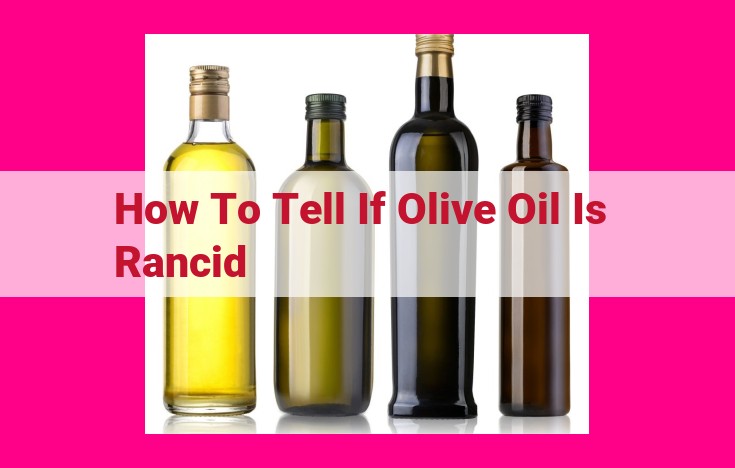Identifying Rancid Olive Oil: Key Indicators, Causes, And Health Implications

To determine if olive oil is rancid, observe its color, odor, and taste. Rancid oil may have a dull, cloudy appearance, an off-odor like paint thinner or crayons, and a bitter or metallic taste. It may also have a higher acidity level, indicated by a burning sensation in the throat. Additional signs include smoking or foaming when heated, and the presence of sediment or cloudiness. Avoid consuming rancid olive oil as it can compromise its nutritional value and have adverse health effects.
Understanding Rancid Olive Oil: A Guide to Maintaining its Quality
Olive oil, a culinary staple and the cornerstone of the Mediterranean diet, adds a rich, fruity flavor to our meals. But like all good things, olive oil has a shelf life. When it goes bad, it becomes rancid, losing its delectable taste and potentially posing health risks. Understanding rancidity is crucial for preserving the integrity of your precious olive oil stash.
What is Rancidity?
Rancidity is the degradation of fats and oils due to oxidation, a chemical reaction triggered by exposure to oxygen. This process occurs naturally over time, but it can be accelerated by factors like heat, light, and microorganisms.
Sensory and Chemical Clues of Rancidity
Rancid olive oil undergoes several telltale changes that are easy to detect:
- Color: Rancid oil often exhibits a darker, muddier hue.
- Odor: It develops an unpleasant, pungent smell, often described as “stale,” “waxy,” or “metallic.”
- Taste: The once-fruity flavor transforms into a bitter, acrid aftertaste.
- Free Fatty Acids: Chemically, rancidity leads to an increase in free fatty acids, which contribute to the unpleasant taste and odor.
Factors Causing Rancidity in Olive Oil
Olive oil, a culinary treasure prized for its health benefits and exquisite flavor, can fall prey to a stealthy enemy—rancidity. This degradation process wreaks havoc on the oil’s quality, transforming its once-inviting aroma into a pungent assault on the senses. Understanding the culprits behind rancidity empowers us to safeguard our precious olive oil investment.
Oxidation: The Silent Culprit
Oxidation is the arch-nemesis of olive oil. This relentless process occurs when oxygen molecules interact with oil molecules, setting off a chain reaction that leads to the formation of free fatty acids. These unwelcome guests contribute to the development of unpleasant flavors and aromas, tarnishing the oil’s once-pristine character.
Microbial Growth: Tiny Invaders
Microscopic microbes can also conspire to ruin olive oil’s reputation. Bacteria and fungi lurk in the shadows, waiting for an opportunity to sneak into the oil. Once inside, these tiny invaders feast on the oil’s components, releasing malodorous byproducts that taint its flavor and aroma.
Light Exposure: Nature’s Enemy
Sunlight may seem like a harmless force, but for olive oil, it’s a formidable adversary. Ultraviolet rays penetrate the oil, triggering a photochemical reaction that accelerates oxidation. This relentless assault results in the formation of off-flavors and aromas.
Heat: The Devastator
Olive oil is not a fan of high temperatures. When exposed to excessive heat, the oil’s delicate compounds undergo an irreversible transformation. Denaturation, oxidation, and polymerization ensue, leaving behind an oil with diminished flavor and nutritional value.
Preserving the Culinary Treasure: Preventing Rancidity in Olive Oil
Olive oil, a culinary elixir, has been revered for its health benefits and delectable flavor for centuries. However, this liquid gold can succumb to the curse of rancidity, a process that steals its nutritional value and transforms its taste into an unpalatable bitterness. Understanding how to protect olive oil from this culinary nemesis is crucial to savoring its exquisite qualities.
Banishing Oxidation, the Chief Culprit
Oxidation, a relentless invader, is the primary force behind olive oil’s descent into rancidity. Exposure to oxygen, light, or heat sparks a chain reaction that breaks down the oil’s delicate fatty acids, releasing unpleasant compounds that taint its flavor. To combat this insidious enemy, olive oil must be shielded in dark, cool environments that minimize its contact with the elements.
Airtight Seal: A Fortress against Oxidation
Just as a warrior needs armor to protect their body, olive oil requires airtight containers to safeguard it from oxidation. When exposed to air, the oil’s surface becomes a battleground where oxygen molecules launch their assault. By storing olive oil in tightly sealed containers, we erect a fortress that shields it from this relentless foe.
Temperature Control: The Guardian of Freshness
Temperature, a fickle ally, can either prolong or hasten olive oil’s journey toward rancidity. Refrigeration or freezing slows down the process, acting as a guardian of freshness. These frigid temperatures hinder the chemical reactions that lead to spoilage, preserving olive oil’s integrity for extended periods.
Enlisting Antioxidants: Nature’s Guardians
In the battle against rancidity, antioxidants serve as nature’s guardians, valiantly defending olive oil from oxidative damage. Vitamin E, a renowned antioxidant, stands as a formidable protector. When added to olive oil, it neutralizes free radicals, preventing them from wreaking havoc on its delicate composition. Similarly, rosemary extract, a botanical ally, lends its antioxidant prowess, shielding the oil from the harsh effects of oxidation.
By implementing these preventive measures, we safeguard olive oil’s culinary legacy, ensuring that its exquisite taste and health benefits continue to grace our kitchens and enhance our culinary creations.